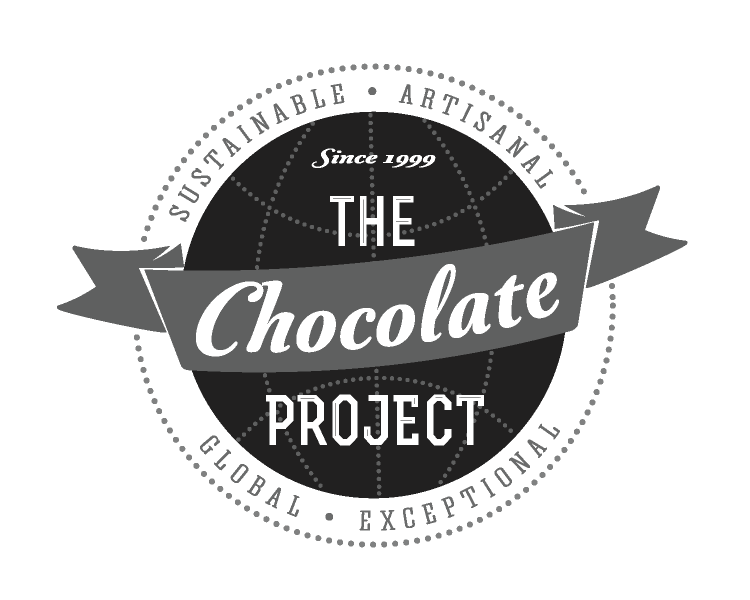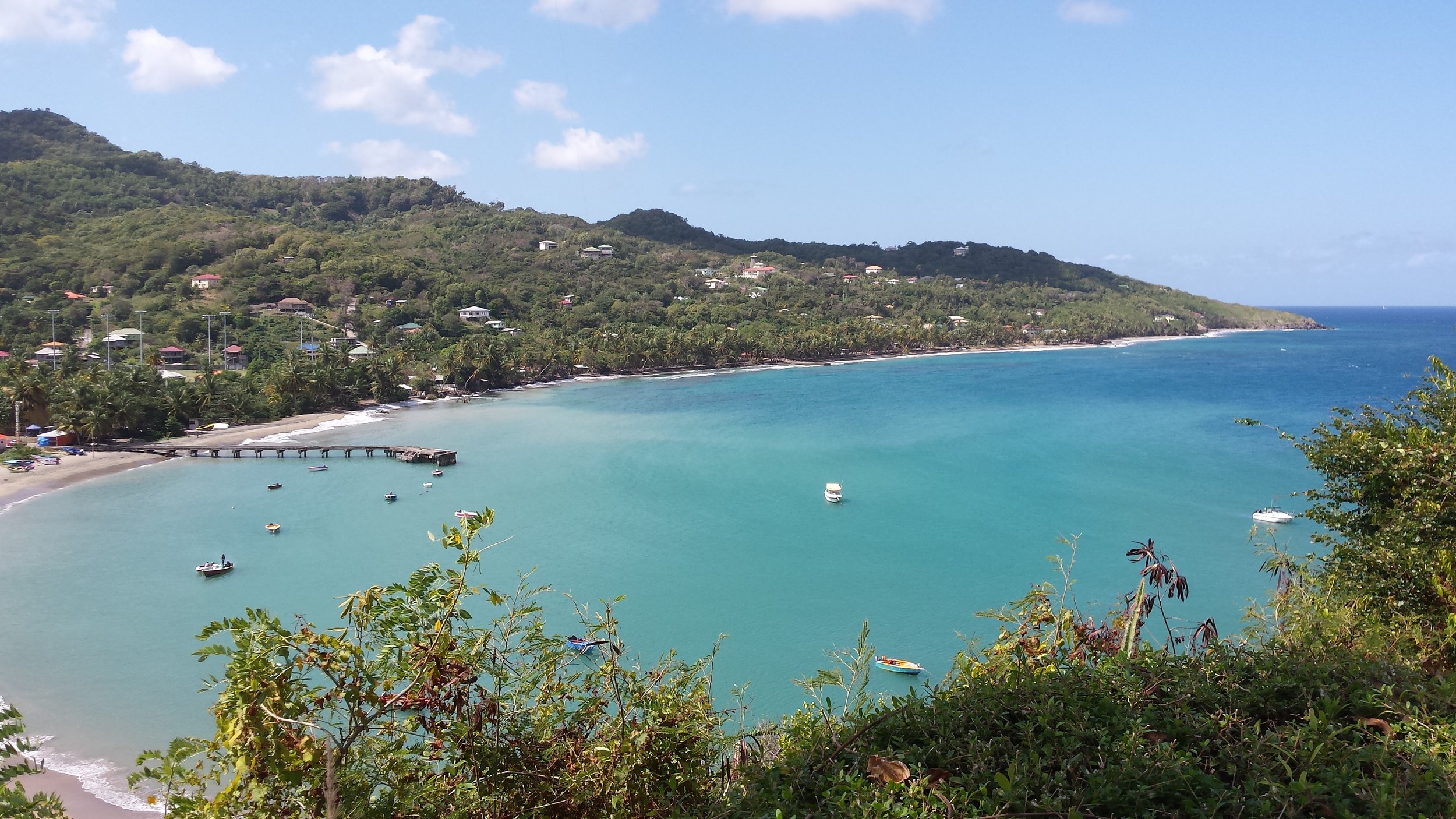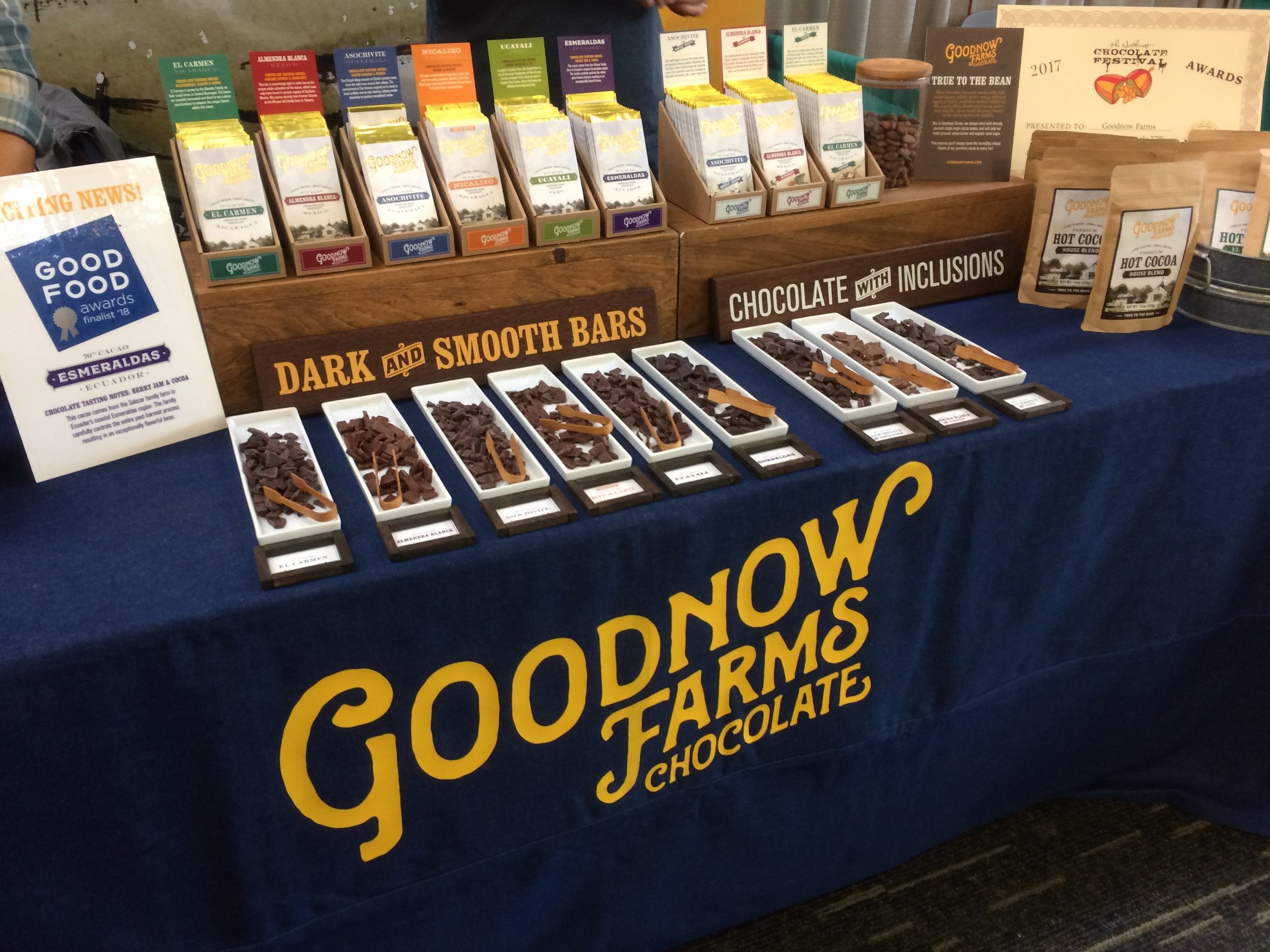As the global pandemic shows no sign of abating, we thought this might be a good time to examine what effects Covid-19 is having on the world of fine chocolate.
Read moreTheChocPro | Race & Chocolate
A vital conversation about Race is happening now, and we want to acknowledge it and say that we are listening and learning…
Read moreAmazon Fires | TheChocPro
It has been painful to watch the news lately and see what is happening in Brazil and Bolivia. Forest fires are burning huge swaths of rain forest and show no sign of stopping. Satellite photos reveal much of the Amazon basin covered in dense clouds of smoke. This is an ecological tragedy, but it is an entirely man-made one. These fires are set by farmers and ranchers who want access to cleared land. The jungle is inconveniently in the way.
Read moreTheChocPro: A Chocolate Day in Grenada
Grenada Bay - January 2019
We spent all of January touring islands in the Caribbean. A particularly memorable visit was our stop in Grenada and a visit to The Grenada Chocolate Company. We have carried their bars for years but actually going there and meeting the individuals behind them makes you taste the bars in a whole new light. Grenada is a ridiculously beautiful island filled with warm and inviting people. That they have an abundance of cacao seems to be almost an unfair distribution of riches.
It is 27 degrees out at eight in the morning as we arrive in Grenada's capital, St. George. Our contacts at the Grenada Chocolate Company have sent a driver to pick us up and we are thrilled to meet Michell, who is charming, knowledgeable - and female. Which makes her a rarity among Caribbean taxi drivers. The drive north to the cacao farm and processing centre is a long one, so we are treated to a full island tour plus plenty of insights into Grenadian life, politics, religion, food and so much more.
In a few weeks Grenada will celebrate their independence day and houses are decorated with green, red and yellow striped banners in preparation. Even the tree trunks and rock walls are brightly painted. Grenadians are a very proud people. After an hour of steep switchback roads, Michell stops at a waterfall so we can stretch our legs and we chat with the vendors who have set up tables here. There is always a small congregation of merchants at every little roadside clearing and pull-out. They are selling fruit gathered from the forest and we snag a couple of delicious "golden apples" - which are a local delicacy like a cross between a mango and a pear. They point out "red sorrel" growing wild and explain how they make a drink by steeping the bright crimson, fleshy blossoms of this native shrub. We buy little baggies of this and enjoy the tart, citrusy beverage on our drive. As you'd expect there is also a vendor selling chocolate, but this is the homemade variety. Just roasted cacao ground into a rough ball and sweetened with a bit of sugar. It is for making hot chocolate drinks out of and each bag of chocolate balls comes with a few shavings of cinnamon bark, a couple of bay leaves and some nutmeg to add a bit of spice to the drink. Everywhere here there are nutmeg trees. Grenada produces almost half the world's supply of nutmeg and mace, which are the seed and seed casing of a non-edible fruit.
Trinitario cacao tree, Grenada.
Leaving the little group of vendors we are excited to see our first cacao tree growing along the road. Equally thrilled to see the second, third and fourth. Then we realize there are thousands of them, interplanted with banana, nutmeg, palm, and taller hardwoods. Grenada has cacao the way Victoria has cherry trees.
Roads in Grenada are narrow, winding, and extremely poorly marked. It is just assumed that if you're driving you know where you are going. All roads are two way even though they are barely wide enough for one car. When two vehicles meet, as happens about every thirty seconds, they have to negotiate a delicate dance to inch past each other. Often one car is on the edge of a cliff while the other is pressed up against the side of a mountain. In towns, driving is further complicated by cars parked along both sides of the street, throngs of people, random farm animals and stray dogs everywhere. Horns are used to indicate whether you want to go through or whether you're letting the car coming at you go first. Horns are also used just to say "Hi". In between telling us stories about Grenada, Michell was constantly honking hello at people she knew or getting honked at herself. Calls of "Mich'-Mich" or "Hey Baby" would be answered with something back from her in Creole. And a horn honk. It appears she knows about half of the ninety thousand people on the island.
We stop at the first chocolate maker on our route, Jouvay, for a tour and tasting. Really nice stuff here, especially their deep, earthy 75% and extraordinarily complex 100% bars. We hike out into their nearby farm to taste some fresh picked Trinitario and stock up on bars to bring home. These folks will be a regular feature now at The Chocolate Project. Back in the van we continue north, passing scenic beaches, small fishing villages and agricultural towns. Eventually, we reach our final stop: The Grenada Chocolate Company. It is a very small, brightly painted house with the chocolate making operations on the ground floor and living quarters above. One of their head chocolate makers, Kaciann, meets us and gives us a lengthy tour while her young son runs about taking pictures with our camera. In the front room there are sacks of cacao that have just arrived and are waiting to be spilled out onto the sorting table. Each bag bears a tag with the names of the farmers who have contributed fruit to that lot. After sorting, the beans move next door to the roasting room which features an old ball-type drum roaster. Next the roasted beans get poured through a hole in the floor down to a vacuum powered winnower that separates the nibs from the husks. Like everything here it is solar powered and designed to be as energy efficient as possible. The nibs proceed in to the vintage stone melengeur, which breaks them down into cocoa liquor. Some of this liquor goes to a press which extracts the cocoa butter but most of it is conched and blocked up for future tempering and molding into bars.
Kemron & David at The Grenada Chocolate Company
In a very small side room we see a plastic folding table and two plastic lawn chairs. This is the wrapping room where two of their staff would normally work encasing each finished bar in foil wrap and then a paper outer label. By hand. One at a time. Today is Saturday though, so everyone has the day off. It never ceases to amaze us when visiting these places how, although their equipment and buildings are far from modern, they still manage to produce world class chocolate. We move next door to the tasting room where Kemron, who is another of their chocolate crafters, leads us through a sampling of all their bars. After many hours of patiently answering all our geeky questions, our hosts bid us farewell and we begin the long drive back. We are buzzing with chocolate and the combination of sun, scenery, tropical air and a truly warm and gracious reception has us happily aglow.
David
TheChocPro | Consider the Cacao Flower
Even if it didn’t give us chocolate, Theobroma cacao would be a fascinating tree. Viewed from a purely botanical perspective there is much to admire and wonder about, from its minute delicate flowers to its glossy green leaves that move to follow the sun’s path across the sky. In today’s post we look deeper at the pollination habits of this native of the Amazon rain forest.
Read moreTheChocPro | Top 10 "Desert Island" Bars (2018)
David's Top 10 Go-To Bars
We get asked daily at The Chocolate Project what our favourite bars are. While we love all the bars we carry some certainly have an extra-special place in our hearts. Here I'll attempt to quantify exactly why each of these bars is meaningful to me. If I was stranded on a desert island this is the chocolate I'd want to be a castaway with.
Read moreTheChocPro | Spotlight on Brazil
The first “Brasil Bean to Bar Chocolate Week” is taking place May 3-6 in Sao Paulo, Brazil. As we couldn't attend, we thought it would be a great opportunity for us to introduce you to Brazil as a cacao origin. Brazil has much to offer the world of fine chocolate... but what's the history of cocoa and Brazil, and why is it not often talked about?
Read moreTheChocPro | Introducing Goodnow Farms Chocolate
Goodnow Farms display at the Northwest Chocolate Festival, November 2017. (Photo by S. Sketchley)
An interview with Tom, co-founder of Goodnow Farms Chocolate.
@thechocpro: Could you briefly introduce yourself and Goodnow Farms?
I'm Tom Rogan and my wife Monica and I are the owners Goodnow Farms chocolate. We started the company in 2015, although we were making chocolate long before that. We spent several years developing our cacao sources in Central America, South America and Mexico before deciding to start making chocolate professionally. Our goal with Goodnow Farms is to make incredible craft chocolate while also sourcing our cacao beans ethically and sustainably.
Read moreTheChocPro | Chocolate Educational Resources
You have tasted some (or lots) of chocolate in your life. Perhaps you've come by The Chocolate Project for our tasting days, or have experienced single-origin chocolate. Maybe you've found a favourite origin or chocolate maker. But you have more questions: I know that I do. There is so much to explore and learn regarding chocolate, and you would like to delve deeper. Where do you start? We have compiled some great resources to start you on your quest for knowledge, at your leisure. These are a few of our favourite go-to resources for beginners and intermediates.
Read moreTheChocPro | The Northwest Chocolate Festival 2017
The Ninth Annual Northwest Chocolate Festival took place in Seattle, WA on November 11-12 this year, and I was excited to attend for the second time. It has sure expanded from my first visit two years ago. It is the top show for artisan chocolate in North America, and one of the best in the world. My favourite aspect of this event is the large Education Program: each day there is a full schedule of workshops, classes, and seminars to attend. These range from speakers sharing stories from origins & farmers; tasting workshops to try fresh cocoa pod fruit, traditional drinking chocolate recipes, baking, and chocolate pairings such as wine & cheese; technical workshops on evaluating chocolate, roasting cacao, tempering, genetic diversity; supply-chain seminars; book-launches; and many more. The most difficult part is choosing which session to attend. And that's all in addition to the exhibitors on the main show floor and all of their information and tastings. Really, one weekend is not nearly enough to absorb it all!
Read moreTheChocPro | Is it time for a second look at West Africa?
One of the most commonly cited differences between commercial chocolate and artisanal chocolate is that big commercial producers use beans from West Africa and craft chocolate makers do not, preferring beans from New World sources such as South America, Central America and the Caribbean. The implication here is that West African beans are of poor quality and suitable only for mass-produced industrial applications. It is a refrain that gets repeated time and again, but is it really true?
Read moreTheChocPro | The Top 3 Misconceptions About Chocolate
We've heard some pretty crazy stuff over the many years of running The Chocolate Project and answering questions. The internet is a prime source of shockingly inaccurate information about the chocolate world and so here we'll try to set straight a few of the most common myths. Keep reading here to learn more!
Read moreTheChocPro | An Ode to Fat
An Ode to Fat
We talk a lot about single-origin chocolate here and wax poetic about exotic flavour notes and rare strains of cacao. Yet rarely do we pay tribute to the magical substance that makes up most of a chocolate bar: cocoa butter. Once cacao beans have been roasted and winnowed they break up into nibs, which look like coarse brown gravel but are in fact more than 50% cocoa butter. A heavy stone grinder and the magical combination of time, heat, and motion reduce the nibs down to minute particles, each enrobed in its own tasty jacket of fat.
Conching further refines this process and tempering provides a finished chocolate that has sheen, snap, and a lush and gloriously slow melt.
So just what is it about cocoa butter that is so special?
Read moreTheChocPro | Fermentation 101
The process for converting the fruit of the cacao tree into chocolate is a complex one. Fermenting the fruit pulp and seeds together is the first critical step and one that is not well understood by chocolate lovers. In today's blog we will take some basic steps toward explaining this remarkable transformation.
Read moreTheChocPro | Costa Rica Trip
Our recent trip to Costa Rica this January was an eye-opener in many ways. The pristine rain forests and volcanic mountain slopes of this Central American country should be capable of producing sublime cacao. Historically though, Costa Rica has only rarely fulfilled this potential. For decades most Costa Rican cacao has been the Amelonado-type Forastero grown in large open field blocks, similar to how bananas and sugar cane are grown. This type of mono-cropping is a recipe for disaster with cacao and, sure enough, in the early 1980s a fungal disease called Monilliasis virtually wiped out the entire nation's production.
Read moreTheChocPro | Pride and Prejudice: The Ethical Dilemma of Chocolate Awards
As we've been preparing for our huge craft chocolate retrospective we have planned for November 18th and 19th, I have been overwhelmed by the response and level of input from many of the world's finest chocolate makers. In the process of soliciting bars from them I have been asking why they keep at it, what advice they would give to up-and-coming chocolate makers, and what they feel is the future of the craft chocolate industry. Their responses have been enlightening, to say the least. A few constant themes have emerged and I feel informed enough to draw up a brief summary based on their input.
Which also has me thinking about the world of Chocolate Awards and how they play into all this. There are a number of organizations that taste, rate, and issue awards for chocolate bars and confections. The two most prestigious are the International Chocolate Awards (ICA) and The Academy of Chocolate Arts (ACA). You might think of these two as the Oscars and the Golden Globes of the chocolate world.
Read moreTheChocPro | Chocolate Trends
Chocolate Trends: Here we'll take a look into the crystal ball and examine some trends on the horizon in the chocolate world.....expect all three of these to figure largely in 2017.
Read moreTheChocPro | What is Conching?
The process of conching is unique to the chocolate industry and critical to the production of fine chocolate. Yet it remains an arcane mystery to most chocolate lovers. Join us in today's blog as we delve deeper into the wonders of the conche...
Read moreTheChocPro | Building a Chocolate Cellar
We get asked many questions about storing and collecting chocolate. With the warm days of summer approaching it seems like a good time to tackle this subject. A dark chocolate bar is a remarkably stable and durable product, yet many people seem unsure of just what to do with it once they've bought one. It is best to think of a fine chocolate bar just like a fine bottle of red wine and treat it the same.
Read moreTheChocPro | Chocolate Collaborations: Beyond the Cacao
This month's blog is not about chocolate so much as it is about the the cool associations that happen between creative people. Artisanal chocolate makers seem to have an affinity for others who are trying to craft a quality product in a pure and ethical way and lately many of them have been partnering with these folks to create some very interesting bars. Shawn Askinosie was one of the first and his “CollaBARation” line showed just how far down this path one could go.
Read more




